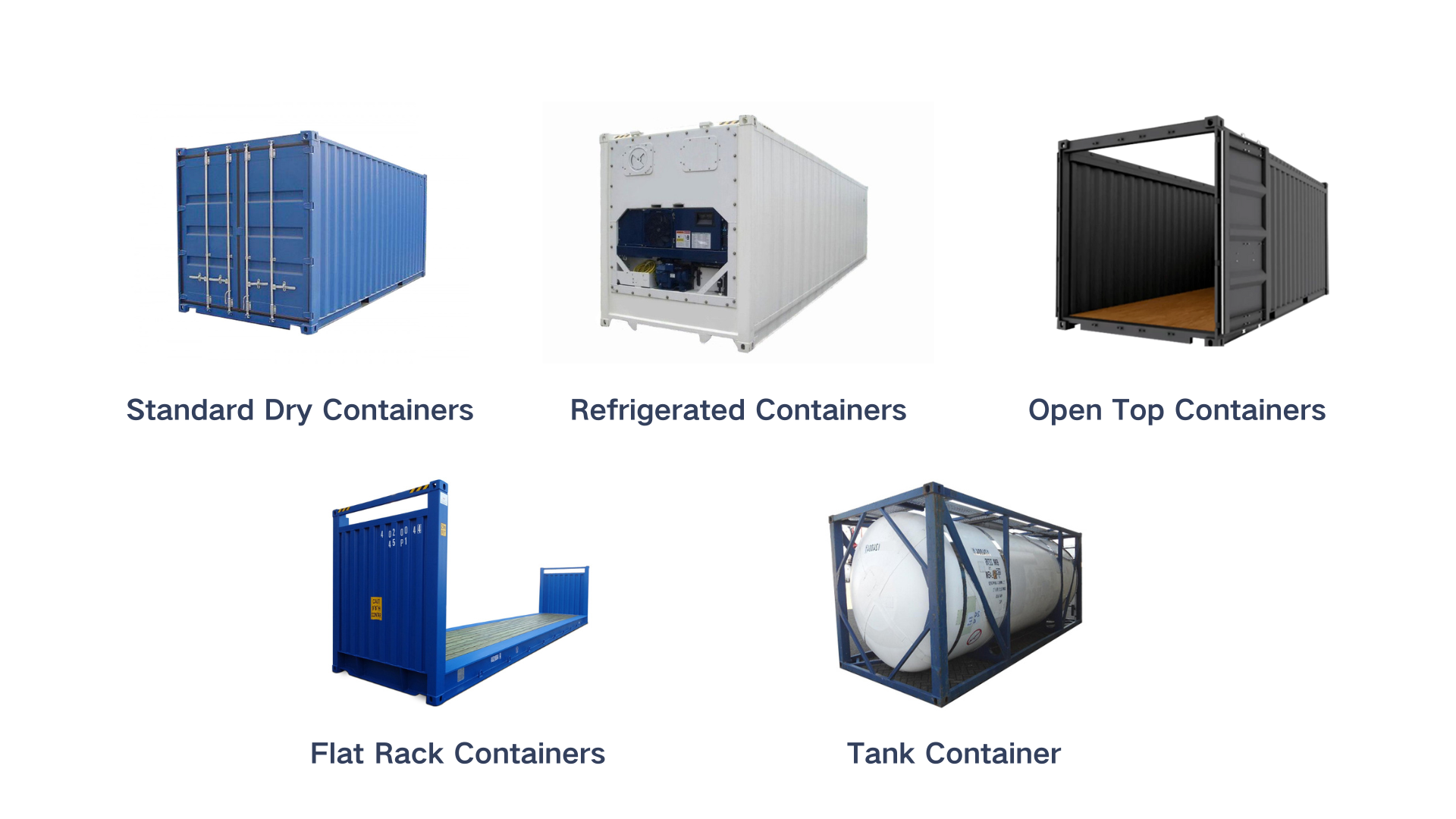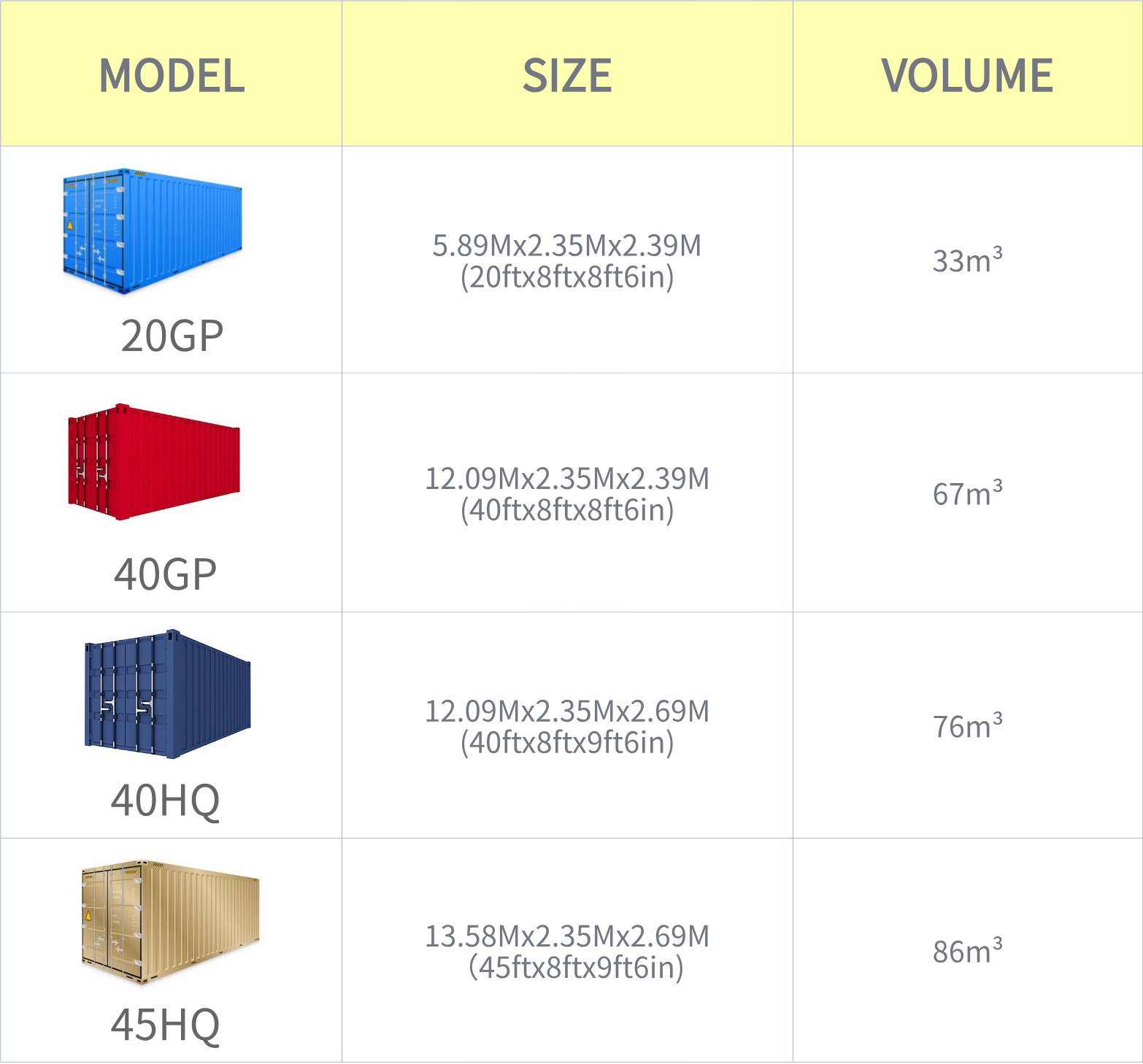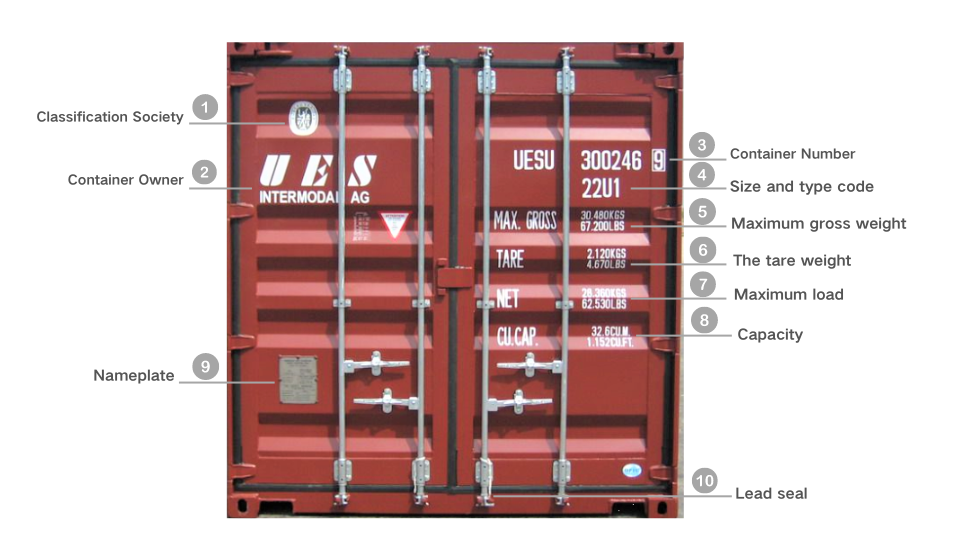The International Organization for Standardization (ISO) played a crucial role in the widespread adoption of logistics containers by setting standard sizes in 1961. Today, the most common sizes are the 20-foot (TEU, twenty-foot equivalent unit) and the 40-foot (FEU, forty-foot equivalent unit) containers. This standardization has allowed for the seamless exchange of goods and has been a catalyst for the surge in global trade.
A Comprehensive Guide to Different Types of Freight Containers
Freight containers come in various types, each designed to meet specific shipping needs. Understanding the different types of containers is crucial for ensuring that your cargo is transported safely and efficiently. Here’s a comprehensive guide to the most common types of freight containers:
Standard Containers
Standard containers, also known as general-purpose containers, are the most commonly used containers in shipping. They are typically used for transporting dry goods such as electronics, textiles, and machinery, with careful consideration of container capacity to maximize efficiency.
- Sizes: Available in 20-foot and 40-foot lengths.
- Features: Fully enclosed with a rigid roof, floor, and sidewalls.
Refrigerated Containers (Reefers)
Refrigerated containers are essential for transporting perishable goods that require temperature control, such as food, pharmaceuticals, and flowers.
- Sizes: Available in 20-foot and 40-foot lengths.
- Features: The temperature can be adjusted between -60℃ and +30℃, ensuring that the goods maintain the appropriate temperature during transportation.
Open Top Containers
Open top containers are designed for cargo that is too high to fit into standard containers, such as heavy items like glass panels, steel, machinery, etc. They are equipped with a removable tarpaulin roof to facilitate loading and unloading of cargo from above.
- Sizes: Typically available in 20-foot and 40-foot lengths.
- Features: Open top with removable roof bows and tarpaulin cover.
Flat Rack Containers
Flat rack containers are used for transporting oversized and heavy cargo that cannot fit into standard containers. They have collapsible sides and no roof, making them ideal for machinery, vehicles, and construction materials.
- Sizes: Available in 20-foot and 40-foot lengths.
- Features: Collapsible sides and end walls, no roof.
Tank Container
Tank containers are used to transport liquid items such as food, medicine, and chemicals.
- Features: Good sealing and corrosion resistance, ensuring the safety of liquid goods during transportation.
In addition, there are many types of containers for special purposes, such as ventilated containers, insulated containers, bulk containers, bulk powder containers, hanging containers, etc.

Understanding Container Sizes: What You Need to Know for Efficient Shipping
Choosing the right container size is essential for efficient shipping. Different container sizes offer varying capacities and are suitable for different types of cargo. Here’s what you need to know about the most common container sizes:
20-Foot Container
The 20-foot container is one of the most commonly used sizes in shipping. It is versatile and suitable for a wide range of cargo, with a focus on maximizing container capacity.
- Dimensions: 20 feet long, 8 feet wide, 8.6 feet high.
- Capacity: Approximately 33 cubic meters.
- Uses: Ideal for smaller shipments, heavy goods, and dense cargo.
40-Foot Container
The 40-foot container is another widely used size, offering double the length of a 20-foot container.
- Dimensions: 40 feet long, 8 feet wide, 8.6 feet high.
- Capacity: Approximately 67 cubic meters.
- Uses: Suitable for larger shipments, lighter goods, and bulk cargo.
40-Foot High Cube Container
The 40-foot high cube container provides an extra foot of height, offering more storage capacity.
- Dimensions: 40 feet long, 8 feet wide, 9.6 feet high.
- Capacity: Approximately 76 cubic meters.
- Uses: Ideal for bulky but lightweight cargo, such as furniture and electronics.
45-Foot High Cube Container
The 45-foot high cube container is the largest standard container size, providing maximum storage capacity.
- Dimensions: 45 feet long, 8 feet wide, 9.6 feet high.
- Capacity: Approximately 86 cubic meters.
- Uses: Suitable for large, bulky cargo that requires maximum space.

Understanding the Main Markings on Containers
- Classification Society: Classification Society or Ship Survey Association, sometimes collectively referred to as Ship Survey Agency.
- Container Owner: The owner of the container, also called the container owner; different container owner codes represent different companies, which are registered by the container owner to indicate the identity of the container owner.
- Container Number: A total of 11 digits, composed of 3 parts
- 4 English letters, the first 3 represent the abbreviation of the container owner (Owner Code), and the 4th represents the type of container.
- 6 digits, representing the container registration code, equivalent to the “ID number” of the container, each container number is unique.
- 1 number, the last number is framed, which is a check code used to check whether there are any errors in the first few digits.
4. Container Type:
- The first digit indicates the size. 2 means 20 feet, 4 corresponds to 40 feet, and L represents 45 feet.
- The second digit indicates the height. 2 represents non-high box, and 4 represents high box.
- The third digit indicates the container type. Such as G1, U1, R1, V1, T1, etc.
5. (MAX. WT.) or (MAX. GROSS): The total weight of the box + goods. KGS stands for kilograms, and LBS stands for pounds.
6. (TARE) is the tare weight: The weight of the container itself.
7. (PAYLOAD) Maximum load: The maximum weight that the container can carry.
8. (CU. CAP) or (CUBE): The maximum loading volume. The unit is cubic meter.
9. Nameplate: The nameplate will reflect the “identity” information of the container; it contains TIR number, manufacturer, box type, production date, TCT number, CSC number, and the owner of the container, as well as ACEP, and ISO-required MGW, TARE, etc. The nameplate is generally installed in a prominent position in the lower left corner of the container door.
10. Lead Seal: The container lead seal is a lock of the container, but it can only be used once. After opening, it will be broken and cannot be used again. There is a seal number on it, which is unique. If the number on the container lead seal received by the customer is the same as that on the bill of lading, it means that the container has not been opened and the goods are intact.

Maximizing Space Utilization: How Many Pallets Can Be Loaded into Containers of Different Sizes?
Efficiently loading pallets into containers is crucial for maximizing space and reducing shipping costs. Here’s a detailed guide on how many standard pallets can be loaded into different container sizes:
How Many Pallets on a 20-Foot Container?
A 20-foot container can typically accommodate 10 standard pallets (48″ x 40″) when loaded in a single tier.
- Single Tier: 10 pallets.
- Double Tier: 20 pallets (if the cargo allows for stacking).
How Many Pallets on a 40-Foot Container?
A 40-foot container can hold up to 20 standard pallets when loaded in a single tier.
- Single Tier: 20 pallets.
- Double Tier: 40 pallets (if the cargo allows for stacking).
How Many Pallets on a 40-Foot High Cube Container?
The extra height of a 40-foot high cube container allows for additional stacking, accommodating up to 21 standard pallets when loaded in a single tier.
- Single Tier: 21 pallets.
- Double Tier: 42 pallets (if the cargo allows for stacking).
How Many Pallets on a 45-Foot High Cube Container?
The 45-foot high cube container provides even more space, fitting up to 24 standard pallets in a single tier.
- Single Tier: 24 pallets.
- Double Tier: 48 pallets (if the cargo allows for stacking).
Notice: The actual loading quantity may vary depending on the shape, size, stacking method of the goods and the actual dimensions of the container. During the loading process, the stability and safety of the goods need to be considered to ensure that the goods will not move or be damaged during transportation. The selection and loading method of the pallet should comply with the relevant regulations and requirements of the transportation company and customs.
The Benefits of Using Logistics Containers
- Efficiency and Speed: Container logistics has streamlined the shipping process, significantly reducing loading and unloading times, thus speeding up the transportation of goods worldwide.
- Cost Reduction: By simplifying the transfer of goods from one transport mode to another and reducing manual handling, logistics containers have substantially lowered shipping costs.
- Safety and Security: Containers provide a secure environment for goods, reducing the risk of theft and damage during transit.
- Environmental Benefits: Containers can be efficiently stacked and transported, reducing the number of trips required and, consequently, the carbon footprint of global shipping.
Challenges and Future Directions Facing Containers
While container logistics has significantly improved global trade, challenges remain. Issues such as empty container repositioning, optimizing for high-value cargo, and evolving security threats require ongoing innovation. Future developments may include smart containers equipped with IoT sensors for real-time tracking and condition monitoring, further revolutionizing the logistics industry.
Conclusion
The invention of the logistics container has been a game-changer for the global economy, making international trade more accessible, faster, and more cost-effective than ever before. As the world continues to globalize, the role of logistics containers will only grow, underscoring their importance in bridging the gap between markets across continents. Their ongoing evolution promises to address current challenges and harness technology for even more efficient global trade networks.
 English
English
 Deutsch
Deutsch Português
Português
 العربية
العربية
 中文
中文







